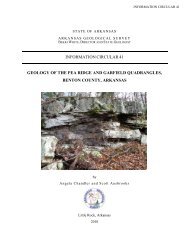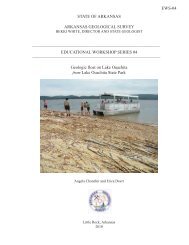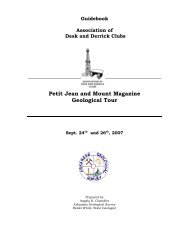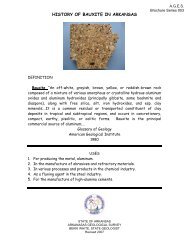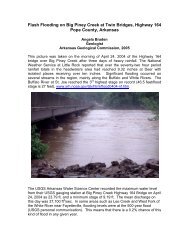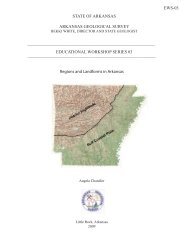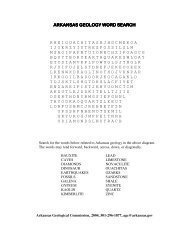Mining, Minerals and More in the Western Ouachita Mountains
Mining, Minerals and More in the Western Ouachita Mountains
Mining, Minerals and More in the Western Ouachita Mountains
- No tags were found...
You also want an ePaper? Increase the reach of your titles
YUMPU automatically turns print PDFs into web optimized ePapers that Google loves.
Figure 5. Tuff conta<strong>in</strong><strong>in</strong>g shale clasts (left) <strong>and</strong> f<strong>in</strong>e-gra<strong>in</strong>ed tuff conta<strong>in</strong><strong>in</strong>g white feldspar fragments(right).In middle Mississippian time mounta<strong>in</strong> build<strong>in</strong>g began as a result of subduction of an oceanicplate beneath <strong>the</strong> North American cont<strong>in</strong>ental plate near what is now sou<strong>the</strong>rn Arkansas (Fig.9). An isl<strong>and</strong> arc system (Fig. 6) probably resulted. It is likely that a vent or fissure <strong>in</strong> <strong>the</strong> systemproduced an extremely violent eruption of magma creat<strong>in</strong>g an ash flow <strong>and</strong> overrid<strong>in</strong>g ashcloud (Niem, 1977). The ash <strong>in</strong>teracted with sea water <strong>and</strong> generated a steam-<strong>in</strong>flatedturbulent slurry of pyroclastic debris (Fig. 7). The slurry was denser than sea water <strong>and</strong> floweddownslope as a density current. The flow<strong>in</strong>g mass scoured <strong>the</strong> muddy sea floor br<strong>in</strong>g<strong>in</strong>g piecesof shale <strong>in</strong>to <strong>the</strong> tuff (Fig. 7). Cont<strong>in</strong>ued eruptions brought more material <strong>in</strong> surges downslope<strong>in</strong>to <strong>the</strong> bas<strong>in</strong>. The pyroclastic flows were deposited with<strong>in</strong> m<strong>in</strong>utes to hours, while f<strong>in</strong>e ash<strong>and</strong> buoyant pumice that floated on <strong>the</strong> sea surface eventually sank to <strong>the</strong> bottom over a muchlonger period of time.Figure 6. Diagram show<strong>in</strong>g possible scenario that occurred dur<strong>in</strong>g <strong>the</strong> <strong>Ouachita</strong> Orogeny <strong>in</strong>Arkansas to form <strong>the</strong> Hatton Tuff (from U.S. Geological Survey).5



